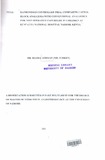| dc.contributor.author | Athman, Biasha | |
| dc.date.accessioned | 2013-05-23T07:38:14Z | |
| dc.date.available | 2013-05-23T07:38:14Z | |
| dc.date.issued | 2001 | |
| dc.identifier.citation | Master Of Medicine In Anaesthesiology At The University Of Nairobi. 2001 | en |
| dc.identifier.uri | http://erepository.uonbi.ac.ke:8080/xmlui/handle/11295/24649 | |
| dc.description.abstract | A prospective study was carried out at Kenyatta National Hospital over a period of three
months (March to May 2001) comparing caudal block analgesia and conventional
analgesics for post-operative pain relief, in two groups paediatric surgical patients
undergoing genitourinary procedures. Both groups consisted of patients aged between one '
and twelve years. The aim of the study was to assess the efficacy of caudal block
analgesia in providing post-operative pain relief and also to determine the incidence of
side effects with caudal block analgesia.
The first group (conventional analgesics) consisted of forty patients, of which males were
thirty two (80%) and females were eighty (20%). The average age of children in this
group was 4.45±3.14 yrs and ranged from one year to twelve years. The average weight
for children in this group was 14.83±5.54 Kg(kilograms) and ranged from eight kilograms
to twenty seven kilograms. Mean duration of analgesia was 50.31±15.96 minutes and
ranged from thirty minutes to seventy five minutes, while the mean duration of surgery
was 33.50±5.99 minutes and ranged from fourteen minutes to sixty five minutes.
The second group (caudal block analgesia) also consisted of forty inpatients, of which
thirty three (82.5%) were males and females were seven (17.5%). The average age for
children in this group was 5.17±3.39 years and ranged from one year to twelve years and
the average weight was 18.l3±6.67 kilograms and ranged from six and a half kilograms
to thirty four kilograms. Average duration of analgesia in this group was 69.08±41.61
minutes and ranged from twenty three minutes to two hundred and forty minutes, while
the average duration of surgery was 52.89±40.85 minutes and ranged from seventeen
minutes to two hundred and twenty minutes.
2
Premedication was the same for all patients, being atropine 0.01 per kilogram body
weight given intramuscularly. Induction was either inhalation with halothane (0-3%),
nitrous oxide (50-70%) in oxygen or with intravenous sodium thiopentone 4-7 mg/kg
body weight. Intubation was facilitated by suxamethonium at a dose of 1 mg/kg body
weight intravenously. Immediately after intubation before any surgical stimulus analgesia
was instituted. Group I received intravenous pethidine 1 mg/kg body weight while group
II received caudal block with bupivacaine 0.25% according to the scheme suggested by
Armitage.
The outcomes were assessed by the pain score of "modified" children's Hospital of
Eastern Ontario Pain Score (mCHEOPS) from immediate post-operatively to 6 hours
post-operatively. The study showed that there was no significant difference in pain scores
from immediately post-operatively to 6 hours post-operatively in the two groups studied.
The incidence of side effects with caudal block analgesia namely nausea, vomiting,
delayed urination, delayed ambulation were also not statistically significant. There was a
significant difference in the duration of anaesthesia and surgery between the two groups
(p <0.05). In this study pain requiring analgesia was defined as an mCHEOPs score of
greater or equal to six (>6) | en |
| dc.language.iso | en | en |
| dc.publisher | University of Nairobi | en |
| dc.title | Randomised controlled trial comparing caudal block analgesia with conventional analgesics for post operative pain relief in children at Kenyatta National Hospital Nairobi, Kenya | en |
| dc.type | Thesis | en |
| dc.description.department | a
Department of Psychiatry, University of Nairobi, ; bDepartment of Mental Health, School of Medicine,
Moi University, Eldoret, Kenya | |
| local.publisher | Faculty of Medicine | en |

